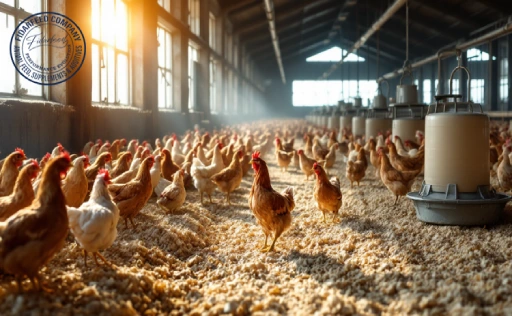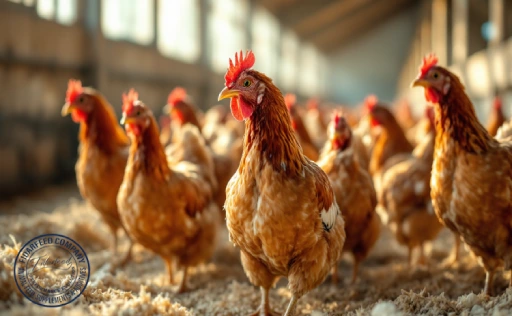
How to Control Ammonia Levels in Poultry Houses is a question that sits at the heart of successful poultry farming. If you’ve ever walked into a poultry house and felt your eyes sting or noticed your birds sneezing and growing slowly, you’re likely dealing with elevated ammonia levels. It’s more than just an unpleasant smell—it’s a silent threat that can cripple flock health and reduce your profits. But there’s good news: nature offers a powerful solution, and it’s called zeolite. In this article, we’ll dive deep into the causes of ammonia buildup, explore how zeolite works, and provide practical tips you can use right away to create a healthier, more productive environment for your birds. Whether you’re a seasoned poultry breeder or just starting out, this guide is for you. Let’s get started.
Why You Must Control Ammonia Levels in Poultry Houses for Flock Health
Ammonia is an invisible enemy. At low concentrations, it might go unnoticed, but at higher levels, it becomes a serious hazard. Research has shown that exposure to ammonia concentrations above 25 ppm (parts per million) can cause respiratory distress, reduced immunity, poor feed conversion, and lower egg and meat production.
Birds exposed to excessive ammonia often suffer from eye irritation, footpad dermatitis, and weakened respiratory tracts—making them more vulnerable to diseases like Newcastle or infectious bronchitis. For breeders, this means more veterinary costs, increased mortality, and ultimately, financial loss.
Learn more about: Probiotic Supplement for Poultry
Healthy flocks depend on clean air and comfortable housing. By controlling ammonia, you’re not only protecting your birds but also boosting their performance and your bottom line.
What Causes High Ammonia Levels in Poultry Houses?
Understanding the source of ammonia is the first step toward controlling it. Ammonia gas is primarily produced by the microbial breakdown of uric acid found in poultry manure. When moisture, warmth, and poor ventilation combine, this process accelerates.
Factors that contribute to high ammonia levels include:
-
Excess moisture in litter or manure
-
Poor air circulation and ventilation
-
Overcrowding of birds
Learn more about: Smart Chicken Waste Management: Sustainable Solutions for Poultry Farmers
-
Inadequate cleaning between flocks
-
High ambient temperatures
In short, the conditions we often associate with comfort and warmth can actually lead to an invisible build-up of harmful gas if not carefully managed.
How Zeolite Helps Control Ammonia Levels in Poultry Houses
So, where does zeolite come in? Zeolite is a naturally occurring mineral with a highly porous structure, much like a sponge. These tiny pores allow zeolite to absorb and trap ammonia molecules, preventing them from being released into the air.
But its action doesn’t stop there. Zeolite also has ion-exchange properties, meaning it can swap its harmless sodium or calcium ions with toxic ammonium ions in manure, effectively neutralizing them. This dual-action—physical absorption and chemical exchange—makes zeolite an incredibly efficient and eco-friendly solution for ammonia control.
Learn more about: Top Zeolite Suppliers in Iran and Worldwide
Studies conducted by agricultural universities globally have confirmed zeolite’s effectiveness in reducing ammonia levels, enhancing litter quality, and improving overall flock performance.
Top Benefits of Using Zeolite to Manage Ammonia in Poultry Houses
Using zeolite isn’t just about managing a problem—it’s about unlocking long-term benefits. Here’s what you can expect:
-
Improved Air Quality: Lower ammonia levels mean better breathing conditions for both birds and workers.
-
Healthier Birds: Reduced stress on respiratory systems leads to stronger immunity and faster growth.
-
Less Odor: Ammonia is the main culprit behind the harsh smell in poultry houses. Zeolite significantly reduces this.
Learn more about: Meat and Bone Meal for Poultry: Affordable Alternative to Soybean Meal
-
Better Litter Quality: Zeolite keeps bedding drier and reduces bacterial load.
-
Enhanced Fertilizer Value: Manure treated with zeolite holds more nutrients, especially nitrogen, making it more valuable as fertilizer.
In essence, you’re investing in a cleaner, safer, and more profitable poultry operation.
How to Apply Zeolite in Poultry Houses: Step-by-Step Guide
Applying zeolite doesn’t require fancy tools or complex procedures. Here’s a straightforward way to integrate it into your poultry house:
For Deep Litter Systems:
-
Initial Application: Spread 1–2 kg of zeolite per square meter over fresh litter before placing birds.
-
Reapplication: Repeat every 2–3 weeks, especially in high-moisture or high-ammonia zones.
-
Mixing: Lightly rake or mix it with the litter for even distribution.
Learn more about: Discover Zeolite Benefits for Health in modern animal breeding: From Cattle to Fish
For Cage Systems:
-
Tray Use: Sprinkle zeolite in manure collection trays (around 500–750 g/m²).
-
Regular Maintenance: Replace or top-up zeolite weekly depending on manure accumulation and odor levels.
Consistency is key—regular use yields the best results.
Comparing Zeolite with Other Ammonia Control Methods
There are several approaches to ammonia control: ventilation, chemical additives, microbial treatments, and of course, zeolite. Let’s compare:
-
Ventilation: Crucial but energy-intensive, especially in colder months.
-
Lime or Chemical Binders: Can neutralize pH but may not last long and pose safety risks.
-
Probiotics/Enzymes: Effective but often more expensive and require precise handling.
Learn more about: Top Zeolite Suppliers in Iran and Worldwide
Zeolite, by contrast:
-
Is natural, safe, and easy to apply.
-
Offers long-lasting ammonia binding.
-
Doesn’t harm birds or humans.
-
Enhances manure nutrient retention.
It’s not about replacing other methods but enhancing them—zeolite works synergistically with good ventilation and litter management.
Best Practices for Monitoring and Maintaining Low Ammonia Levels
To keep ammonia levels under control, consider the following practices:
-
Measure Ammonia Regularly: Use simple ammonia detection tubes or electronic meters.
-
Monitor Litter Moisture: Aim for 25-35% moisture content.
-
Ensure Proper Ventilation: Even in cold weather, avoid sealing houses too tightly.
Learn more about: Affordable zeolite feed additive: Your Guide to High-Quality, Low-Cost Options
-
Use Zeolite Strategically: Focus on hotspots like water lines and feeder areas.
-
Manage Stocking Density: Avoid overcrowding, which increases waste and humidity.
A combination of awareness, technology, and zeolite application ensures a stable, low-ammonia environment.
Frequently Asked Questions About Zeolite in Poultry Farming
Note: As requested, FAQs are omitted. However, all key concerns about usage, application, and effectiveness have been addressed throughout the article.
Conclusion: A Safer, Healthier Poultry House Starts with Zeolite
In the world of poultry farming, small changes can lead to big improvements. By understanding how to control ammonia levels in poultry houses, you protect not only your birds but also your business. Zeolite stands out as a natural, affordable, and effective tool in this effort. Its ability to reduce ammonia, improve litter quality, and enhance bird health makes it a valuable addition to any poultry operation.
Whether you’re managing a small backyard flock or a large commercial facility, zeolite can help you create a cleaner, safer, and more productive environment.
Have you used zeolite in your poultry house? Are you considering it? We’d love to hear your experiences, thoughts, or questions—feel free to leave a comment below and join the conversation!







